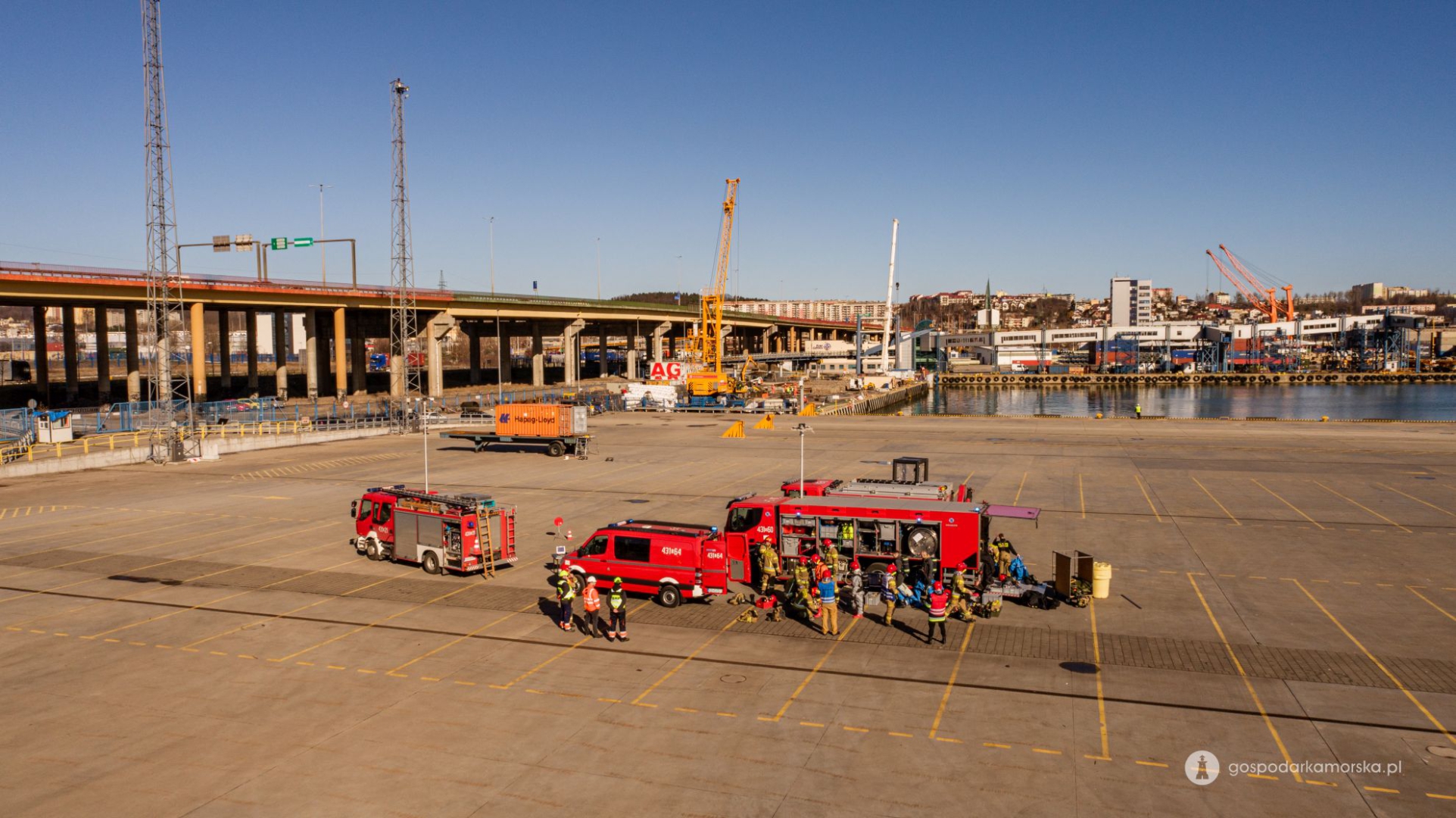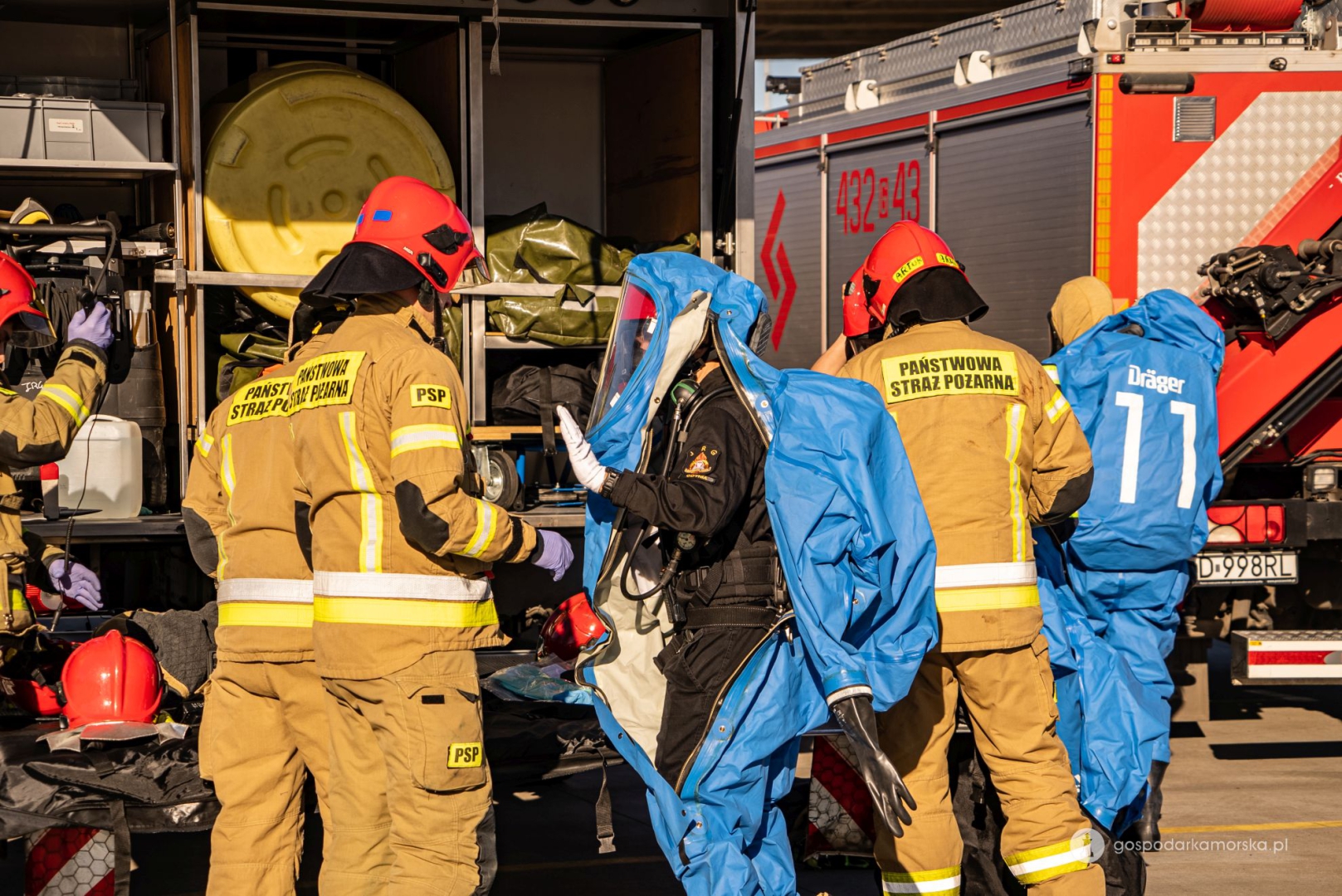![GCT and fire department practice with dangerous substances [VIDEO] - MarinePoland.com GCT and fire department practice with dangerous substances [VIDEO] - MarinePoland.com](https://www.marinepoland.com/zdjecia/artykul/1791/6684/1200x0/2/gct1.jpg)
Considering
the number of containers handled at Gdynia Container Terminal each
week, it is common sense to assume that dangerous situations may
occur. All services should therefore always be operationally ready.
Therefore, when in February smoke began to come out of one container
with dangerous cargo on the yard, the fire brigade arrived on the
spot as soon as possible.
One of the employees of Gdynia Container Terminal noticed that an unknown substance was leaking from one of the sea containers stored at the company's yard in the dangerous cargo sector. The situation was dangerous - an employee reported feeling dizzy, so it was assumed that the container contained chemicals dangerous to people and the environment, not reported in the documents. All this happened in the morning hours of February 28, fortunately only as part of exercises conducted jointly with the Health and Safety Department of Hutchison Ports Gdynia and the Specialist Group of Chemical and Ecological Rescue "Gdynia" of the State Fire Service. Their goal was to check and possibly refine the procedures and rules in force in the terminal in the event of similar events, and to improve rescue and firefighting skills.
In
accordance with the applicable procedures, the faulty container from
which the mysterious dangerous substance was leaking was first placed
in a special tank preventing the chemical agent from entering the
environment and the waters of the Gulf of Gdańsk, and then
transported to an isolated place. The fire department was also
notified.
The
vehicles of the Specialist Chemical and Ecological Rescue Group
"Gdynia" appeared on the spot. Rescuers started to act,
going through the successive elements of the scenario and checking
various possible variants of the situation.
–
It was established that the substance, according to the information
provided, is sodium hydroxide, but the rescuers kept in mind that
there may be additional hazards. That is why we have always tried to
ensure that the rescuers have a safety level one higher. Recognition
was made, rescuers temporarily secured leaks from the bathtub on
which the container was placed. Then they got into the container and
took measurements. A radioactive source of cesium-137 has been
simulated. Rescuers determined that it was a sealed substance. It was
possible to temporarily remove it from the container. They could then
focus on removing the source of the leak. It turned out that it was
one of the IBC containers, i.e. a plastic tank with a capacity of 1
m3, in which there was an aqueous solution of sodium hydroxide –
the course of the exercises is described by Capt. Mateusz Szultka
from the Fire and Rescue Unit 1 Gdynia Śródmieście, commander of a
specialist chemical and ecological rescue group. One of the last
elements of the exercise was the pumping of the substance into the
emergency container, which was delivered by the container terminal.

–
Today we practiced how our internal procedures will work in the event
of a dangerous chemical substance being released from a sea
container, how employees will behave, whether everything will run
properly – comments Maciej Romanowicz, health and safety
specialist, port facility security officer at GCT. – I think it
went well, but we will still discuss the course of the exercise, all
the points, check if everything worked properly – he adds.
As Maciej Romanowicz says, such situations practically do not happen in reality.
–
The probability of such situations is very small, but we must be
ready for all variants – he assures. Therefore, GCT, in
consultation with the services, tries to organize similar exercises
at least once or twice a year. – Each time the scenario is
different. We practice not only with chemistry, but it can also be
work at height, rescue, or typical fire and extinguishing activities.
Such
events are also valuable for the firefighters and rescuers
themselves, who also want to be ready for all kinds of threats that
may arise during terminal operations.
–
Our operational planning department tries to be in constant contact
with the management of the terminal and other institutions that
operate in port areas. We try to organize joint exercises. If these
are not strictly operational exercises, involving the operation of
hosts, we want to be up to date with what is happening here, what
types of materials can be transported, get acquainted with the area
of these facilities, the safety procedures that apply here, health
and safety regulations – says Szultka.

Interestingly,
Gdynia Container Terminal is not located in the area of operations of
the Port Fire Brigade, which operates in areas closer to Śródmieście
of Gdynia, and precisely the Rescue and Fire Fighting Unit 1 Gdynia.
–
When it comes to major events, even if it is the area of the Port
Fire Brigade, we still help, whether as ordinary firefighters or as a
chemical rescue group. It all depends on what the needs are at the
scene. We are available all the time, provides st. Cpt. Szultka.
Gdynia
Container Terminal pays great attention to ensuring an appropriate
level of security during its operations. Terminal employees regularly
train together with the fire brigade and other services. Last year,
GCT was also a co-organizer of extensive training of service dogs
under the name "Cerberus". The terminal also held exercises
on evacuation from heights for crane operators or on the use of AED
defibrillators for office workers.


